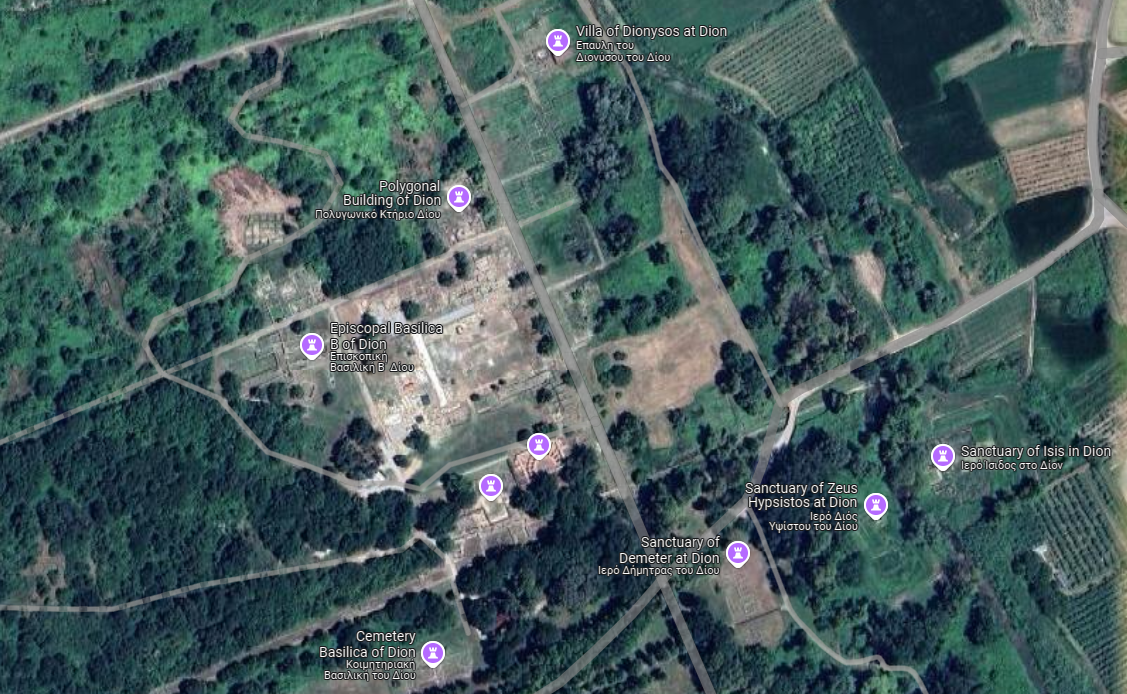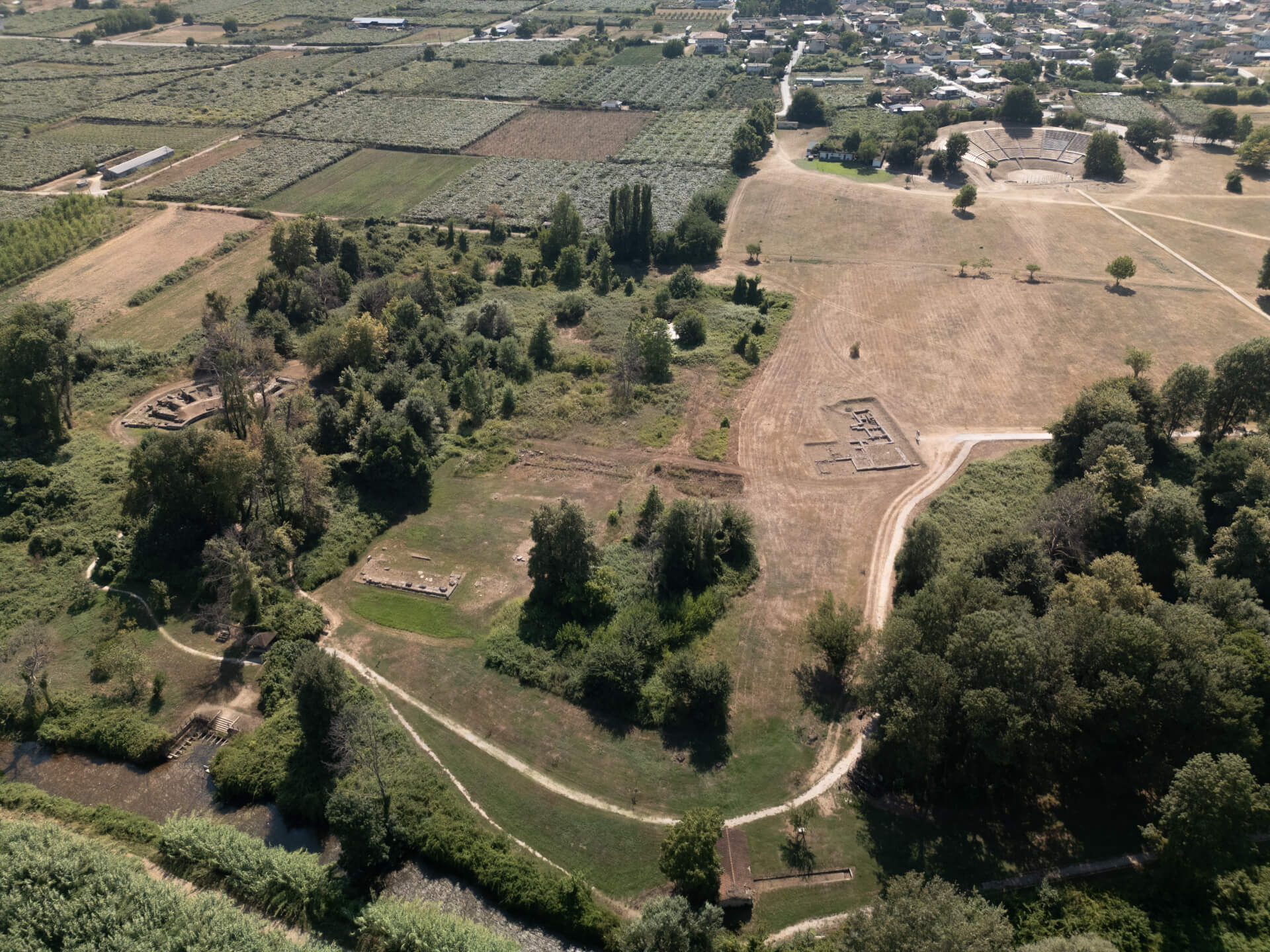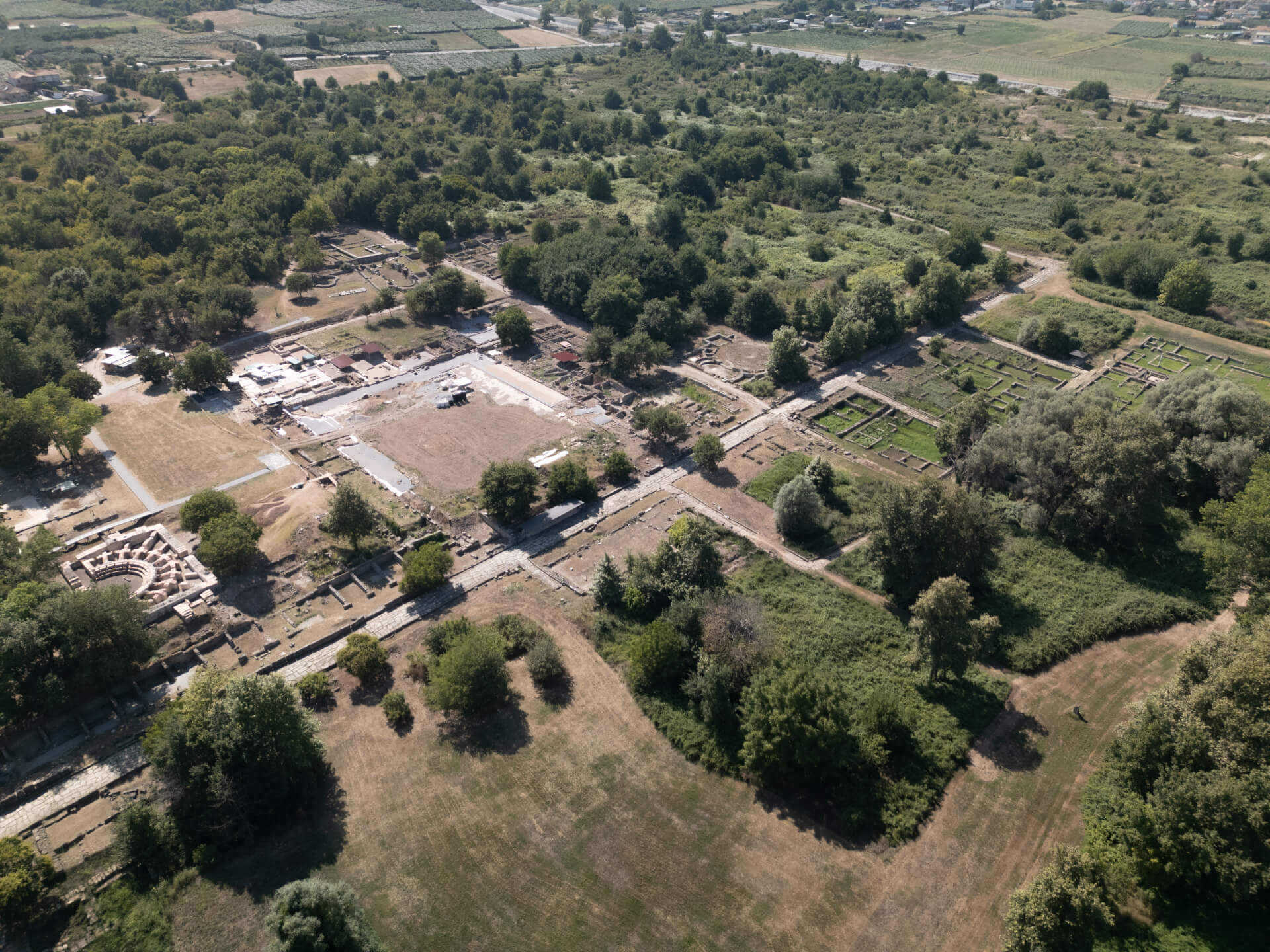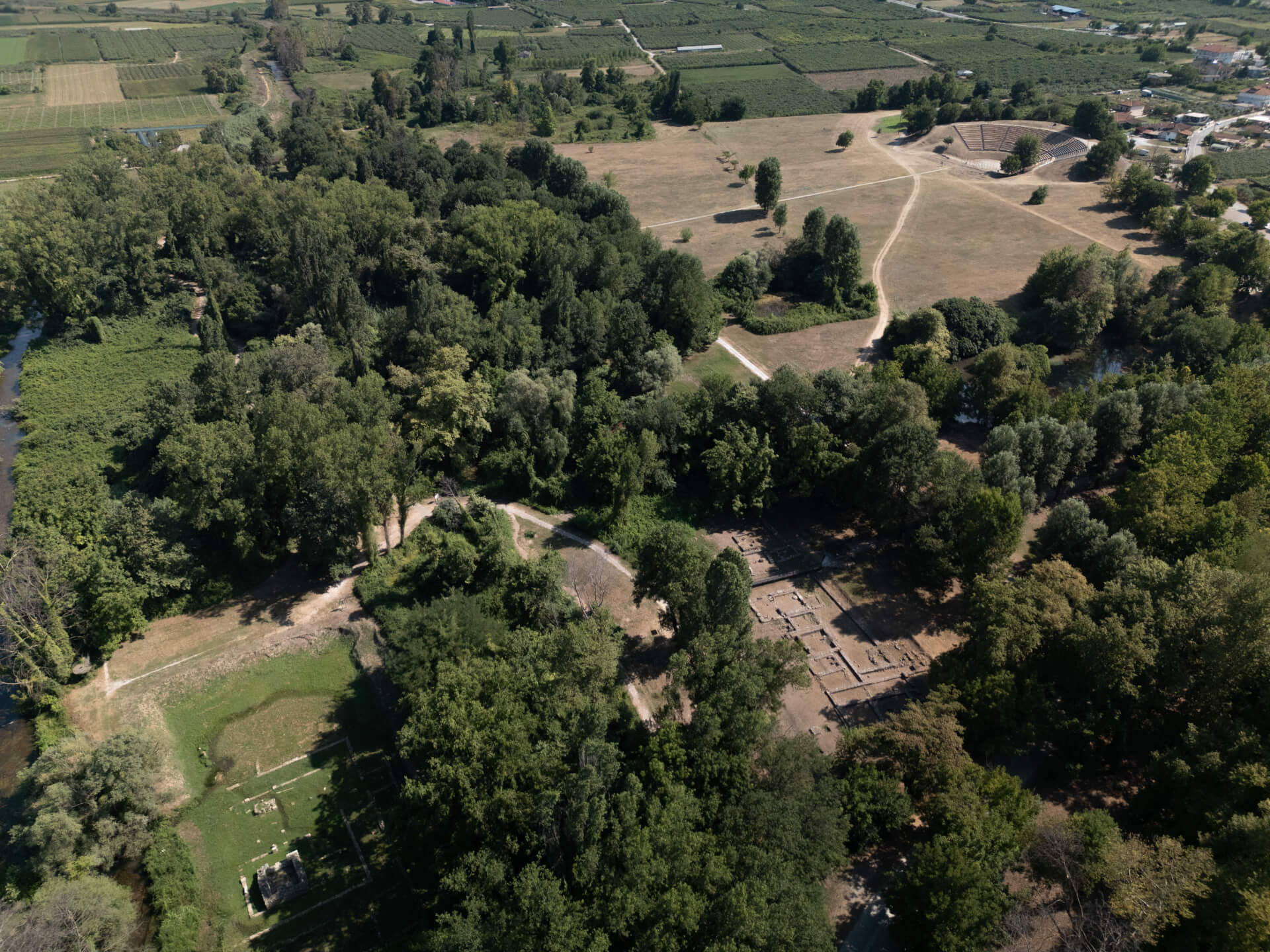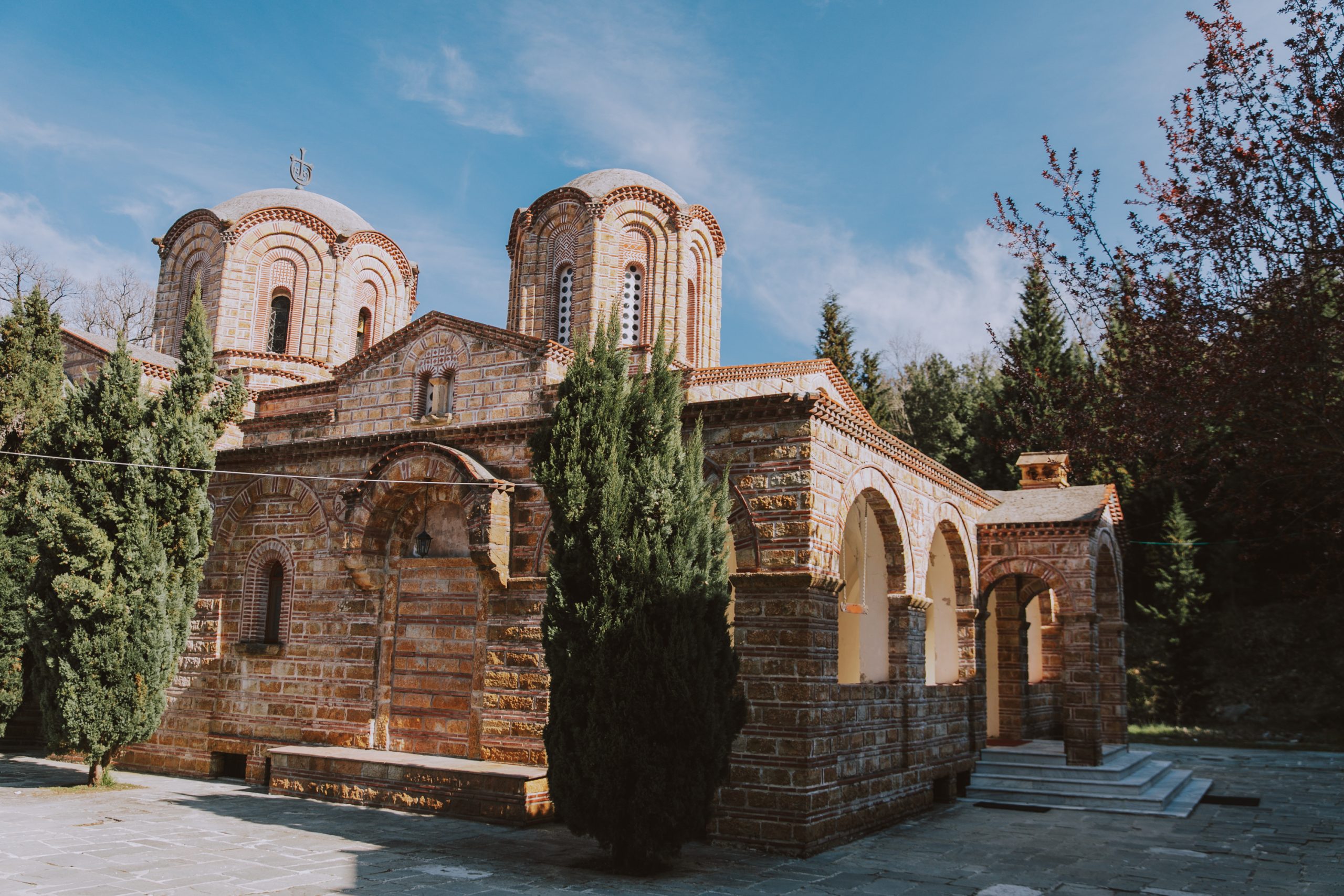Dion
Dion: The holy city of the Macedonians
The archaeological site of Dion is located in the prefecture of Pieria, at the eastern foothills of Mount Olympus and at a distance of 10 km from Katerini. It covers an area of about 370 acres, including the area of the sanctuaries and the ancient walled city, which extends over 89 acres and was inhabited without interruption from classical to early Christian times. The work carried out brought to light private residences, public buildings, shops and workshops entirely integrated into building blocks defined by streets.
The city was built in the 2nd century BC. on flat ground at the foot of Olympus and about 5 km from the sea, to which it was connected by the navigable river Vaphyras. Its walls covered a square area with an exemplary layout, typical of the know-how of the age of Alexander the Great, although the current image of the city corresponds mainly to the Roman and late Roman periods.
The main street of Dion, which is 670 meters long, crosses the city from north to south and is paved with large slabs, with the design corresponding to the typical urban fabric of Hellenistic times. The vertical and parallel road arteries that end in the main street are part of a Hippodamian urban planning system.
Constructions of the 2nd and 3rd centuries AD. show that the region was particularly rich and its inhabitants were wealthy. The ancient city also housed the Great Thermal Baths, an impressive complex of buildings built around a large courtyard around 200 AD, which included shops, workshops, places of recreation and worship, public toilets and a small theatre.
To the east, the great mansion of Dionysus was discovered, which took its name from the large mosaic composition depicting the god that covers the floor of the banqueting hall. Outside the walls, the city’s sanctuaries, the Hellenistic and Roman theaters and the stadium were also discovered.
It is worth noting that among the gods worshiped in Dion, the dominant position was occupied by Olympian Zeus (Greek: Δίας), after whom the city was named. In the temple of the god, stone columns were found with texts referring to alliance treaties, border arrangements and honorary resolutions.
The Sanctuary of Demeter, located in the south, is the oldest Macedonian sanctuary that we know to this day, while further east another sanctuary was discovered dedicated to the Egyptian gods Sarapis, Isis and Anubis. In the same sanctuary, there is a small temple of Aphrodite Hypolympidia, that is, Aphrodite who was worshiped under Olympus.
Finally, the Hellenistic theater of Dion is located outside the city walls and was built in the years of Philip V (221 – 179 BC), while the Roman theater was located southeast of the Hellenistic theater and dates to the 2nd century AD.
Archaeological Park of Dion
Opening hours: Daily 08:00 – 20:00 (last entry 19:40)
The Sanctuary of Olympian Zeus
The Sanctuary of Olympian Zeus in Dion was one of the most revered places in ancient Macedonia, with a central role in the religious and political life of the region. It is located near the Roman theater and south of the sanctuary of Asclepius. Olympian Zeus was worshiped with magnificent sacrifices by the Macedonian kings during the great festival of “Olympiain Dion”, which acquired a pan-macedonian character at the end of the 5th century BC, and it became the national worship of the Macedonians.
The sanctuary included a large 22-meter long altar, made of large corner stones on the outside and half-baked bricks on the inside. West of the altar there were 36 stone bases for tying animals for sacrifice. Also, there was a one-room building with dimensions of 9 x 13.30 meters, which probably housed the statue of the god.
Archaeological findings in Dion, such as a 100-meter long wall that was probably the precinct of the mosque, fragments of sculptures and reliefs depicting Zeus, confirm the importance of the sanctuary. Epigraphic evidence also show that the sanctuary of Zeus in Dion was an important place for the Macedonian kingdom, as important texts were published there and statues of Macedonian kings were erected. The first inscription is in fact a letter from Philip V, with which he settled the borders between the Demetrians and the Feraeans in Thessaly. The second inscription is a resolution of the city, which dates back to the end of the 4th century BC. In both of these epigraphic testimonies it is expressly stated that they were to be placed in the sanctuary of Olympian Zeus.
In the summer of 219 BC, the sanctuary was set on fire by the Aetolian army. The inhabitants of Dion rebuilt the sanctuary and buried many damaged votive offerings in pits, which were found in the excavations and contained valuable royal inscriptions.
The cult of Olympian Zeus continued even after the accession of Macedonia to the Roman Empire. The emperor Hadrian, known for his philhellenism and for the fact that he was worshiped under the name “Olympius”, probably contributed to the revival of the worship of Zeus.
The Sanctuary of Demeter
The temple of the goddess Demeter in Dion is the oldest known Macedonian sanctuary with continuous function from the end of the Archaic period to the beginning of the 4th century AD. Excavations revealed important findings, such as pottery and kernoi , a clay piglet effigy, a marble head of Demeter and a skyphos with an incised votive inscription, confirming that the sanctuary was dedicated to this goddess.
Moreover, two two -chambered buildings with an eastern facade and dimensions of 11 x 7 meters were found, as well as many small one-chambered houses of worship from the classical and hellenistic periods. These “houses” had cult statues and stone tables, on which the first fruits of the harvest were probably deposited.
The archaeological excavations also brought to light a small figure with a veil, as well as a statue of Aphrodite, along with an altar with an inscription confirming the worship of the goddess in the sanctuary, as well as the worship of Baubo, associating the site with feritlity .
The Sanctuary of Isis
The sanctuary that was discovered consisted of 4 temples, with the central one dedicated to the worship of Isis Lochia, that is, the protector of childbirth. This fact is evidenced by inscribed pedestals on its steps, as well as a relief, marble column from the 2nd century AD, which represents the goddess with windrow and a scepter in her hands, while also bearing a foundation inscription.
The temple had an antechamber and a nave (main interior space in ancient Greek temples), and was built on a high pedestal . Its Ionic style architecture advocates its dating to the era of Severus. The built-in altar of the temple was found intact, surrounded by votive offerings, while on its steps there were marble bulls as a depiction of the god Apis.
The small temple to the north of the central one was dedicated to the cult of Aphrodite Hypolympidia , that is, the Venus who was worshiped on the outskirts of Olympus. The building had only one chamber and a tank in place of the floor, the water of which came from a conduit under the alcove of the cult statue. The southern part of the temple has not been identified with the worship of any god or goddess, although a statue belonging to the god Eros was discovered there.
The fourth temple with a alcove was dedicated to Isis Fortuna. As evidenced by the differences in masonry, as well as its placement outside the construction line of the other buildings, it was built later on.
The sanctuary was destroyed by natural causes such as earthquakes and floods, but the deposit of silt kept it in good condition. Before its destruction, evidence shows that it coexisted with the first Christian basilica of Dion.
The Great Thermal Baths
The Great Thermal Baths, the public baths of Dion, were built around 200 AD in the south of the city and formed the core of public life, as they offered the citizens of the imperial times a luxurious and comfortable environment for discussion and socializing.
It consisted of a spacious atrium in the center, which was surrounded by shops, workshops, public toilets, places of recreation and worship, as well as a small theater. The yard was also used for sports activities, while the conservatory was used for artistic events.
The central building, reached after crossing the large courtyard and seeing the conservatory on the right, had swimming pools, changing rooms, heated and cold water areas, rest rooms, sweat and massage rooms. A modern for the time water supply and drainage network ran underground, while a system of hypocausts ensured the necessary heating in the spaces.
Between the tubs, an extraordinary mosaic depicts Tritons, Nereids and a bull with a cetacean’s tail. Apparently, statues of Poseidon, Dionysus and a Nymph were found in the cold room. In the north wing of the complex, at least ten sculptures were found depicting Asclepius and the Asclepiades, Epione, Machaon and Podalirius, Panacea, Aegle, Aceso, Hygieia and perhaps Iaso, statues that emphasized the healing properties of water.
The Mansion of Dionysus
The majestic “Mansion of Dionysus”, named after the amazing mosaic of scenes from the life of the wine god that decorates the floor of the central room, is one of the most remarkable architectural ensembles in ancient Dion, built around 200 AD. The mansion is located in one of the smaller streets of the eastern part of the city, behind shops and workshops and next to a bath building with large mosaic floors. A courtyard with an Ionic peristyle and a well led to the dining room of the villa, the so-called tablinum of the Romans. Smaller rooms followed, one of which had a semicircular alcove and a statue of Dionysus with a horn in his left hand, while the floor was decorated with geometric patterns. The room was probably dedicated to the worship of the god.
The most brilliant space of the mansion was the banquet hall, almost square, with an area of about 100 sq.m. The floor of the hall was covered with colorful mosaic depicting scenes from the cult of Dionysus. A large painting dominated the center, surrounded by smaller paintings on each side. A spiral band of meander divided the paintings into two parts: the area for the beds of those who took part in the symposium, distinguished by a wide strip of abacus decoration around the walls, and the rest of the room, which had no furniture. The central theme was the triumph of Dionysus: the god was depicted naked in a chariot drawn by sea panthers, holding a rhyton in his right hand and a thyrsus in his left. Beside him stood a Papposilinos in a woolen tunic and a crimson garment. Two sea centaurs , carrying vessels on their shoulders, led the panthers. The white color of the mosaics of the ground, in contrast to the deep blue of the waves, gave a monumental character to the figures, creating the impression of a painting. The paintings that surrounded the main one depicted theatrical masks.
The original decoration of the hall probably included bronze bed fittings and statues of members of the imperial family, deities and civilians. The mansion was probably destroyed by a fire caused by an earthquake.
The mosaic, discovered in 2002, originally remained in the mansion grounds, protected by a canopy. However, water that flooded the area no longer allowed it to remain and be maintained in its natural position. Thus, it was transferred to the Store Gallery of Dion, a building created specifically for its display and preservation.
The Hellenistic theater
In the south of the city of Dion, west of the Sanctuary of Demeter, lies the ancient Hellenistic theater, the largest building of the Archaeological Park of Dion. In the summer months, with a capacity of 4,000 spectators, it hosts most of the performances of Olympus Festival.
The form of the theater corresponds to the typical theater of Greek antiquity. It is an open-air structure, with a northeast direction for good ventilation, on the slope of a low, natural hill. The orchestra, with a diameter of 26 meters, was built on pulverized soil and was surrounded by a sewer structure for the drainage of rainwater. The sewer was uncovered, with two bridges above it for the actors to cross. The stage was probably wooden and placed a little higher than the current one. Underneath the orchestra there was an underground corridor connecting two rooms. The pediment of the theater building was decorated with a Doric entablature, while the roof was covered with curved tiles.
Unique to the Hellenistic theaters was the type of seats in the audience seating area (cavea). The semi-circular rows of seats were covered with mud bricks with dimensions 50 x 50 x 7 cm, while the seats were half a brick high. Before the beginning of the Roman period, the seats were covered with marble. The current form of the theater is the result of a modern reconstruction on the ancient foundations, with the seats in the audience area now covered with wooden boards.
The current theater was built during the Hellenistic period, probably during the reign of Philip V (221-179 BC). An earlier theater occupied the same site, probably destroyed during the attack of the Aetolian League, around 220 BC. Philip V immediately rebuilt the city of Dion, the sanctuaries and the theater. Inside the structure was found a large amount of coins depicting Philip V. In Roman times (from 168 BC), useful building materials of the theater were removed to build a new, Roman theater near the Sanctuary of Zeus.
The Roman Theater
The Roman theater of Dion is located southeast of the Hellenistic theater, outside the city limits, near the Sanctuary of Zeus. It was built in the 2nd century AD and probably replaced the older theatre, which seems to have had limited use after 168 BC.
The theater was built on level ground with an eastern orientation and was smaller than the Hellenistic one. Similar to the theaters of Corinth and Patras, it had a cavea with a radius of 16.45m, an orchestra with a diameter of 10.7m, a stage and proscenium. The cavea was divided into four wings by three narrow staircases and bounded externally by a high semicircular wall. The stands rested on the ceilings of eleven radially arranged, wedge-shaped spaces with arches, which were open to the semicircular corridor that surrounded the outer wall. The theater had 24 rows of seats, of which very few have remained today.
The stage was independent of the hollow and richly decorated with precious marbles and sculptures, however, much of it has been destroyed by the gushing waters. At least four parts of the cavea and the stage underwent alterations, dating to the last quarter of the 4th century AD, based on coins found during the excavations. These interventions are probably because of the collapse of parts of the theater due to earthquakes or to a partial change of its use.
Archaeological Museum of Dion
The findings from the Archaeological Park of Dion are displayed in the museum of the same name, in sections corresponding to the area where they were discovered. One of the most important exhibits is the hydraulis, one of the oldest known musical instruments. It dates back to the 1st century BC and is the oldest of its kind that has been found to date. It is the first keyboard instrument of antiquity and a forerunner of the church organ of Western Europe.
On the 1st floor, there are indicative findings from the excavations in ancient Pydna, as well as from other areas of archaeological interest in Pieria. In the basement, there is an educational exhibition on “Daily life in ancient Dion”, while in a specially designed room, audiovisual material about ancient Dion and Mount Olympus is shown.
Winter Season 1/11-31/3
Opening hours
8:30-15:30, Tuesdays closed
Ticket price: €4 for all visitors
Summer Season 1/4-31/10
Opening hours
8:00-20:00, Tuesday 11:00-18:00
Ticket price: €8 regular, €4 reduced
Phone: (+30) 2351053206
In the following link, you can see in detail the current opening hours of all archaeological sites, monuments and museums:
https://www.culture.gov.gr/el/service/SitePages/view.aspx?iiD=2710
In the following link, you can see the categories of visitors who are entitled to free entry or a reduced ticket, as well as the days when the museums operate with free entry for all visitors:
https://www.culture.gov.gr/el/service/SitePages/view.aspx?iID=2695
Other points of interest near the destination Dion
Whether you’re interested in exploring ancient ruins, enjoying the natural beauty of Mount Olympus, relaxing on pristine beaches or experiencing modern Greek urban life, Katerini is a destination that promises a memorable and enriching experience.






